Published on: 9/20/2015IST
King of Diamonds: The Koh-I-Noor Diamond
“Koh-I-Noor” diamond which in English means “Mountain of Light” has always been in center of debate/controversy. The sole debate now days is that it should be returned to India, the birth place of diamond as it was taken by Britishers in 1850. In 2013, U.K Prime Minister David Cameron during his visit to India said that it would be illogical to return the diamond. Now, the question arises why it should not be returned to India? And if not returned to India, is it right for Britain to claim its possession? According to Gemological Institute of America, India was the only source of Diamonds in the world till 1896. Some of the biggest, brightest and precious stones of the world were mined from Indian mines like Koh-I-Noor, Daria-i-Noor, Noor-ul-Ain. Here we would be covering history of Koh-I-Noor diamond, how it was passed to British Crown and proof that India’s claim for diamond is correct.
Origin of Diamond: -The exact origin of Koh-I-Noor is not confirmed but there have been many theories proposed for its origin like:
1) It was believed that diamond was mined from Kollur mines, in the present-day Guntur district of Andhra Pradesh during the reign of the Kakatiya Dynasty and at that time it was installed it in a temple of a Hindu goddess as her eye.
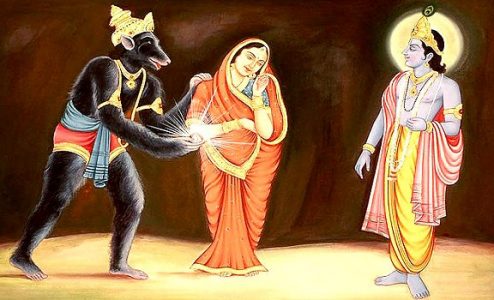
A 18 days fight between Lord Krishna and Jambavantha resulted in transfer of diamond from later to former.
2) The diamond was mined from Kollur mines during 3200 B.C. It was passed to Jambavantha. Lord Krishna tracked Jambavantha to his cave and fought with him for eighteen days, after realizing who Krishna was, Jambavantha submitted. He gave Krishna the gem and also presented him his daughter Jambavanti. Lord Krishna called the diamond “Samantik Mani” and said:
“He who owns this diamond will own the world, but will also know all its misfortunes. Only God, or a woman, can wear it with impunity.”
Slave Dynasty of Delhi had its possession and then it was won by Hindu King of Madhya Pradesh. The Malwa king of Madhya Pradesh were defeated by Kakatiya Empire. They took the possession of the diamond and installed it as one eye of Hindu Goddess in their temple.
3) The third story states that the Koh-I-Noor was the part of biggest diamond in the world “Great Moghul” that weighed 793 carat and has mysteriously disappeared in 1665.
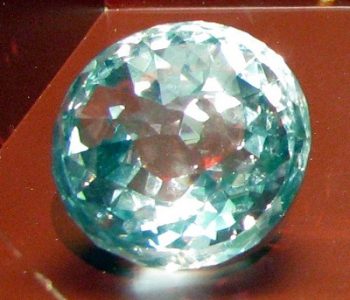
Replica of Great Mogul Diamond, Similar to Koh-I-Noor Diamond. Image Source: wikipedia.org
Diamond at the time of Origin: When it was mined and uncut it was the largest diamond in the world weighing 793 carat. Historian said that at that time it was size of a hen’s egg and in form of a rhombic dodecahedron.
Transfer to Muslim Rulers of India: In 1310 the army of Khilji Dynasty made a successful raid on Warangal and they acquired the diamond. After Khilji dynasty it was transferred to Tughlaq dynasty, Lodi dynasty and finally came into hands of Babur. At that time it was referred as “The Diamond of Babur”. When Babur took the possession of the diamond, he valued it “at the price of two days food for the whole world”. After Babur his son Humayun was engaged in wars with Sher Shah Suri and Akbar, Humayan’s son never kept the diamond with him. Later Shah Jahan built the Taj Mahal in Agra, and he placed the diamond into his Peacock Throne. Aurangazeb, Shah Jahan’s son not only dethroned him but imprisoned him in the Agra Fort. It is said that Aurangazeb placed the diamond in such a way that Shah Jahan could only see the beautiful Taj Mahal in a reflection from Koh-I-Noor.
First Cutting of the Diamond: When the diamond was in possession of Aurangazeb, he asked Hortensio Borgio a Venetian to re-cut the diamond. Hortensio Borgio took three and half year to cut the diamond and reduced it to 186 carat. Aurungzeb saw this and he became so angry that he refused to compensate and ordered to behead him. During this time Tavernier, a French traveller was the first person to sketch Koh-I-Noor.
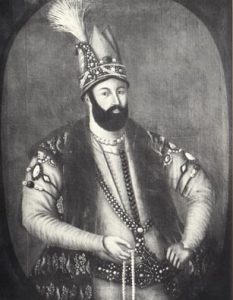
It is said that after looting Delhi Nadir Shah became so rich that he stopped taxation in Iran for a period of three years. Image Source: wikipedia.org
Transfer to Nadir Shah of Persia: Nadir Shah of Iran made an attack on Indian mainland in 1739 and Mughal Army was easily defeated. At the same time local population of Delhi killed few soldiers of Persian army and Nadir Shah ordered massacre of the local population. 20,000 to as many as 150,000 people lost their lives and massacre was stopped when Muhammad Shah offered keys of his treasury to Nadir Shah. Shah took control of jewels in the Royal Treasury, that included the famous Peacock Throne and Darya-ye Noor i.e. “Sea of Light”, but Koh-I-Noor was not there.
Muhammad Shah hid the diamond in the folds of his turban and this was known to few including a eunuch. The disloyal eunuch passed the information to shah and shah planned to take away the diamond from Mughal emperor. When Nadir Shah was about to return back to Iran, he reminded Muhammad Shah that they should exchange the turbans between kings as a sign of friendship. It was done so quickly that Mughal King was left with no choice but to exchange the turban. After the ceremony was over Nadir Shah ran into his apartments and unfolded the folds of his turban and he found the hidden diamond. Amazed by its size, beauty, and brilliance, he exclaimed: “Koh-i-noor,” which in Persian means “Mountain of Light.” This is how the diamond got its current name and there is no reference of such name prior to this. The value of Koh-I-Noor calculated by one of Nader Shah’s consorts was:
“If a strong man take five stones, and throw one north, one south, one east, and one west, and the last straight up into the air, and the space between filled with gold and gems, that would equal the value of the Koh-I-Noor.”
Return of Diamond Back to India: In 1747, Nadir Shah was assassinated by his own guards
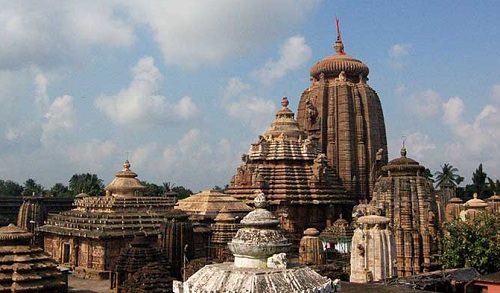
Raja Ranjit Singh agreed to donate the diamond to Jagannath Temple, India but he was not able to speak, nor his will was executed. Image Source: myoksha.com
and the diamond came in control of Shujah Shah Durrani but he was defeated and made prisoner by his brother, Mahmud Shah. However, before being captured, he managed to send his family to Punjab to seek refuge with Maharaja Ranjit Singh. Maharaja marched and got Shah Shuja released and took the possession of Koh-I-Noor. Ranjit Singh wore the diamond on all the important occasions. It is said that at the time of death of Ranjit Singh in 1839, his priests tried to get the diamond to be donated to the Temple of Jaggannath. Though he agreed, he was unable to speak and so the royal treasure refused to release the diamond.
Accusation of Diamond by East India Company: The Sikhs were defeated in Anglo-Sikh war and Britishers didn’t executed the will of Raja Ranjit Singh. According to Treaty of Lahore:
”The gem called Koh-i-Noor which was taken from Shah Shuja-ul-Mulk by Maharajah Ranjit Singh shall be surrendered by the Maharajah of Lahore to the Queen of England.”
Lord Dalhousie was the Governor-General of India and he made arrangement to transfer the diamond to Queen Victoria. According to Dalhousie the stone (Koh-I-Noor) was spoil of war and it should be surrendered from defeated one into the hands of conqueror of diamond, rather than presenting it as a gift to queen. So Duleep Singh handed over the diamond to the Queen at a ceremony on 3 July, 1850, at that time Duleep Singh was only 13 years old.
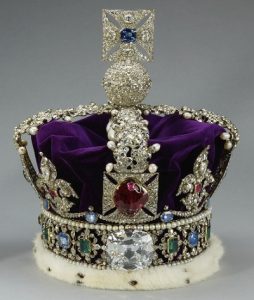
Currently the diamond is set into Maltese Cross of Queen Crown.
Center of Attraction at the Great Exhibition of 1851: The diamond brought from India was displayed at The Great Exhibition of 1851. It was one of the most popular attractions of the India exhibit, Daria-i-Noor diamond (cousin of Koh-I-Noor) was also present. For the diamond The Times reported:
“The Koh-i-Noor is at present decidedly the lion of the Exhibition. A mysterious interest appears to be attached to it, and now that so many precautions have been resorted to, and so much difficulty attends its inspection, the crowd is enormously enhanced, and the policemen at either end of the covered entrance have much trouble in restraining the crowd.”
Second Cutting of the Diamond: At that time the diamond weighed just over 186 carats and it was huge diamond but disappointing in appearance. So the decision was taken to recut it, and Messrs Coster of Amsterdam were given the job. It took 38 days, 12 hours each and £8,000 for overall cutting. The diamond was cut from 186 carats to 105.6 carat which reduced the weight of it by 42% and emerged as an “oval brilliant”. Afterwards the diamonds was mounted in a brooch which Victoria often wore. It was given special status and was kept at Windsor Castle rather than with the rest of the crown jewels at the Tower of London.
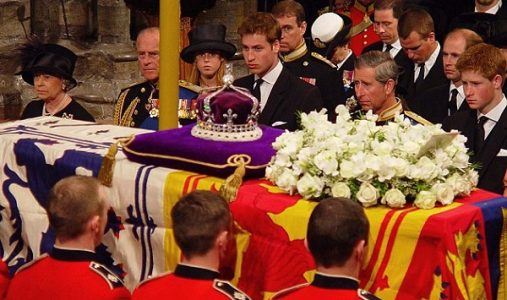
When the Queen Elizabeth died in 2002 the crown was placed on her coffin, with koh-i-noor embedded. Image Source: dailymail.co.uk
Current state and Location of Diamond: The diamond was mounted in a tiara for the Queen and then incorporated in the coronation crown of Queen. In 1937 the Koh-i-Noor was transferred to a crown made for the Queen Elizabeth and there it remains to this day, set into a Maltese cross. When the Queen Mother died in 2002 the crown was placed on her coffin for her lying in state. When Queen Victoria died she left in her will that the Koh-i-noor should only be worn by a female queen because she was also aware of the fact:
“He who owns this diamond will own the world, but will also know all its misfortunes. Only God, or a woman, can wear it with impunity.”
9/20/2015 | | Permalink
